修辞学复习
自考现代修辞学综合复习资料
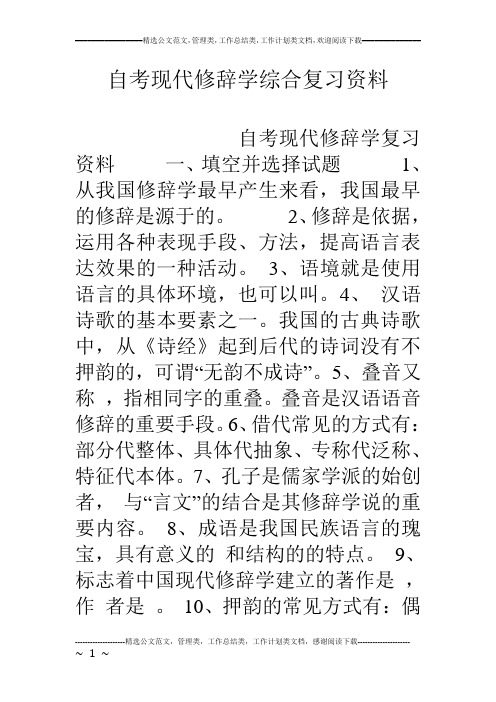
自考现代修辞学综合复习资料自考现代修辞学复习资料一、填空并选择试题1、从我国修辞学最早产生来看,我国最早的修辞是源于的。
2、修辞是依据,运用各种表现手段、方法,提高语言表达效果的一种活动。
3、语境就是使用语言的具体环境,也可以叫。
4、汉语诗歌的基本要素之一。
我国的古典诗歌中,从《诗经》起到后代的诗词没有不押韵的,可谓“无韵不成诗”。
5、叠音又称,指相同字的重叠。
叠音是汉语语音修辞的重要手段。
6、借代常见的方式有:部分代整体、具体代抽象、专称代泛称、特征代本体。
7、孔子是儒家学派的始创者,与“言文”的结合是其修辞学说的重要内容。
8、成语是我国民族语言的瑰宝,具有意义的和结构的的特点。
9、标志着中国现代修辞学建立的著作是,作者是。
10、押韵的常见方式有:偶韵,即押韵,隔句押韵。
排韵,即押一韵,或“一韵到底”。
12、标志着中国现代修辞学建立的著作是,作者是13、根据拈词和拈体的组合关系,拈连可以分为:、14、1951年《人民日报》连载了吕叔湘、朱德熙的名著15、四个音节的语音段落也称,它两字一顿,整齐匀称,是人们喜闻乐道的一种语言格式。
90、把人或事物的声音、颜色、情状如实描写出来的修辞方式叫摹绘。
91、“修辞立其诚”中“修辞”的意思是。
A. 修饰文辞B.提高语言表达效果C. 修治文教,即修治文化教育D.说话92、《修辞学发凡》一书把修辞格分为。
A.二十种 B.三十种 C.四十种 D.三十八种93、我国最早对比喻作出精辟解释的是。
A.孔子 B.墨子 C.孟子 D.荀子94、《国际歌》“最可恨那些毒蛇猛兽,吃尽了我们的血肉” 中的“毒蛇猛兽”属于。
A.明喻 B.借喻 C.暗喻 D. 暗喻95、诗经“一日不见,如三秋兮”中的“三秋”是。
A.比喻“三年” B.借指“三年”C.借指“三个季节”D.比喻“三个季节” 96、“风樯动,龟蛇静,起宏图。
”中的“龟蛇”指“龟山、蛇山”,属于。
A.具体代抽象B.部分代整体 C.专称代泛称D.特征代本体97、李白“日照香炉生紫烟,遥看瀑布挂前川。
汉语修辞学期末复习指导一

汉语修辞学期末复习指导一、单选题1,所谓“修辞”,就是表达者(说写者)为了达到特定的交际目标而应合题旨情境,()以期收到尽可能好的表达效果的一种有意识的、积极的语言活动。
(B)A,对文化进行调配B,对语言进行调配C,对文学进行调配D,对数字进行调配2,()是一种利用语音相同或相近的条件,或是利用词语的多义性、叙说对象在特定语境中语义的多解性来营构一语而有表里双层语义的修辞文本模式。
(D)A,反复B,比喻C,拟人D,双关3,()是一种将本该一句话即可直说明白、清楚的,却为着委婉含蓄的目的,故意迂回曲折地从侧面或是用烘托法将本事、本意说将出来,让人思而得之的修辞文本模式。
(D)A,拟人B,比喻C,反复D,折绕4,()是交际者言及可能触犯受交际者忌讳或社会习俗禁忌的事物时,为了避免或缓解对受交际者的心理刺激,有意“换言易语”予以规避甚或美化的一种修辞文本模式。
(B)A,反复B,讳饰C,拟人D,双关5,()是一种将人们习用或熟知的成语或名句的某一部分藏却,而以其中的别一部分来替代说出的修辞文本模式。
(A)A,藏词B,拟人C,双关D,比喻6,()是表达者在特定情境下因不便完整表达其意,而故意吞吐其辞,将所要表达的意思说一半留一半,甚至将最关键的信息也留而不言,但借助特定语境的帮助,又不至于让接受者不可理解的一种修辞文本模式。
(C)A,反复B,讳饰C,留白D,双关7,()是一种正意而用反话来表现的修辞文本模式。
(C)A,留白B,双关C,倒反D,比喻8,()是一种运用古代历史故事或有出处的词语来说写的修辞文本模式。
(D)A,留白B,双关C,倒反D,用典9,()是一种说写中表意相当明白而又在辞面上故作掩饰的修辞文本模式。
(D)A,双关B,倒反C,比喻D,推避10,()是一种在特定语境中通过临时编造一个故事来寄托其讽刺或教导意向的修辞文本模式。
(A)A,讽喻B,双关C,倒反D,用典11,()是一种通过联想将两个在本质上根本不同的事物由某一相似性特点而直接联系搭挂于一起的修辞文本模式。
汉语修辞学复习重点

汉语修辞学复习重点第⼀章修辞学概说修辞研究的范围,积极修辞与消极修辞,书⾯语修辞与⼝语修辞,表达⽅式与建构⽅式,积极修辞:刻意使⽤特殊的⽅法或形式(如修辞格),⽣动地表现个⼈的巧妙⽂思。
消极修辞:通过调整语⾳、字词、句式,以及表达的⽅式,从⽽使语⾔达到准确、简明、连贯、得体的效果。
表达⽅式和建构⽅式修辞作为表达⽅式——为了增强表达效果,更好地描绘事物,更好地表达感情的语⾔⽅式。
修辞作为建构⽅式是指——修辞作为⾔语⾏为,通过语⾔表达某种情绪、思想,进⽽影响⼈们的思维和⾏动。
修辞是这两个⽅⾯的统⼀体。
修辞作为建构⽅式语⾔建构的世界与客观世界本⾝是有偏差的,或者只是强调了事物本来的⼀个⽅⾯。
语⾔是⼀种⾏为,⼀⽅⾯为了表达,另⼀⽅⾯为了影响、引导⼈们的思想和⾏为。
如何引导就是修辞策略的问题。
修辞——⼈们依据具体的⾔语环境,运⽤各种表现⼿段、⽅法,有意识、有⽬的地组织建构话语和理解话语,以取得理想的交际效果的⼀种⾔语交际⾏为。
修辞的原则: 得体性是修辞的根本原则;美辞性是修辞的重要原则第⼆章语⾳修辞汉语语⾳的特点1、元⾳占优势,乐⾳多,响亮悦⽿。
(元⾳响亮、可以构成押韵。
)2、汉语是有声调的语⾔,四声分明。
(使语⾳抑扬有致,平仄相配。
)落花⼈独⽴,微⾬燕双飞。
3、汉语以单⾳节语素为主,⼀个字就是⼀个⾳节。
(汉语组合灵活,易于调配节奏。
)是惯⽤语、谚语等熟语。
第⼆节押韵和谐什么是押韵?——韵脚的韵腹、韵尾相同,贯⼝:整齐押韵、快速流畅的⼝语段⼦。
第三节双声叠韵和叠⾳⼀、双声叠韵⼆、叠⾳(叠字)叠⾳美在哪⾥?使表达更加形象⽣动使语⾳更加和谐流畅第四节讲究平仄平声长⽽扬,仄声短⽽抑,交错使⽤,声调错落有致,就会有抑扬顿挫的美感。
有时为了平仄和谐,可以适当改变词语的结构。
谐⾳就是对同⾳现象的利⽤。
利⽤同⾳词、近⾳词可达到巧妙的修辞效果三、近义词语的配合1、加强表意,同时起到⾳节匀整平稳的作⽤。
2、避免⾏⽂的单调重复,使之有变化性。
汉语修辞学期末考试重点
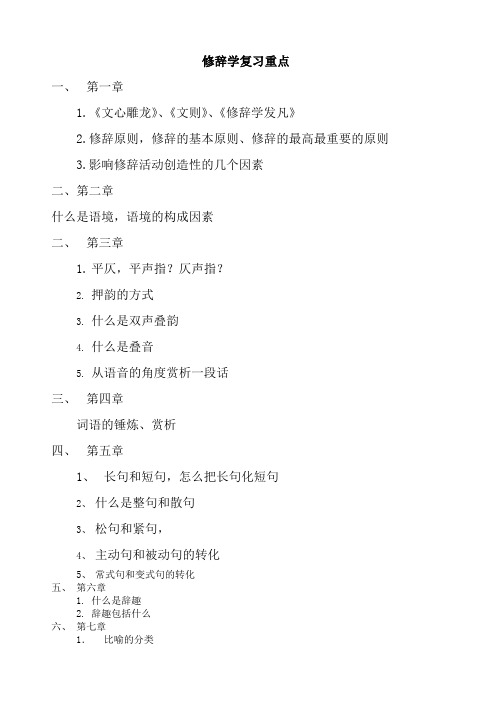
修辞学复习重点
一、第一章
1.《文心雕龙》、《文则》、《修辞学发凡》
2.修辞原则,修辞的基本原则、修辞的最高最重要的原则
3.影响修辞活动创造性的几个因素
二、第二章
什么是语境,语境的构成因素
二、第三章
1.平仄,平声指?仄声指?
2.押韵的方式
3.什么是双声叠韵
4.什么是叠音
5.从语音的角度赏析一段话
三、第四章
词语的锤炼、赏析
四、第五章
1、长句和短句,怎么把长句化短句
2、什么是整句和散句
3、松句和紧句,
4、主动句和被动句的转化
5、常式句和变式句的转化
五、第六章
1.什么是辞趣
2.辞趣包括什么
六、第七章
1.比喻的分类
2.比拟的分类
3.借代的分类
4.移就的分类,比拟和移就的区别
5.什么是对偶,对偶的分类
6.回环的分类
7.排比的分类
8.夸张的分类
9.辞格的连用,辞格兼用,辞格套用
九、第八章
1.语体的含义
2.语体的分类
3.各类语体之间的区别
考试题型:
1.填空题
2.选择题
3.判断题
4.名词解释(从以下选三个考:对偶、语体、双声叠韵、整句、押韵、语境、粘连)
5.简答题(3题)
6.应用题(句式的变换)
7.赏析题(诗歌赏析,辞格赏析)。
汉语修辞学期末复习资料
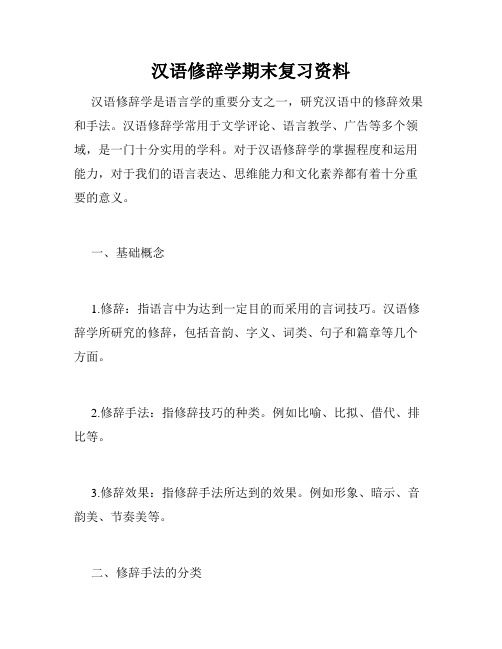
汉语修辞学期末复习资料汉语修辞学是语言学的重要分支之一,研究汉语中的修辞效果和手法。
汉语修辞学常用于文学评论、语言教学、广告等多个领域,是一门十分实用的学科。
对于汉语修辞学的掌握程度和运用能力,对于我们的语言表达、思维能力和文化素养都有着十分重要的意义。
一、基础概念1.修辞:指语言中为达到一定目的而采用的言词技巧。
汉语修辞学所研究的修辞,包括音韵、字义、词类、句子和篇章等几个方面。
2.修辞手法:指修辞技巧的种类。
例如比喻、比拟、借代、排比等。
3.修辞效果:指修辞手法所达到的效果。
例如形象、暗示、音韵美、节奏美等。
二、修辞手法的分类1.形象类比喻:通过比较可以表达出某种感情或思想的手法,例如“他像一只狼一样嚎叫”。
拟人:将非人类物品或抽象事物拟人化,例如“花儿笑了”。
拟声:模拟某种声音,例如“咚咚咚”的敲门声。
2.辞格类对仗:重复相同词或句型的结构形式,例如“你爱我,我爱你”。
对偶:重复相同的意思,例如“让我们团结起来,战胜一切困难”。
通假:用近义词、反义词、同音词等词汇,来刻画某种形象或表现一种思想。
3.转化类借代:用一个词表示另一个事物,例如“龙凤呈祥”中的“凤”代表女子。
转喻:一种常用于文学作品中的修辞手法,通过引用另一文学作品,来表现出自己的情感。
省略:一种将某些信息隐含在文本内部的辞格手法。
三、修辞效果的分类1.形象美:通过修辞手法来创造形象的形状、内容、颜色、细节等方面的美感。
2.音韵美:修辞手法可以使汉语表达充满音韵美感,例如排比、押韵等。
3.节奏美:通过修辞手法可以创造文本的节奏美感,例如对仗、对偶等手法能够使汉语表现出动感和韵律感。
四、其他相关知识1.对于汉语修辞学的学习,需要多读好的文学作品,并对其中的修辞手法和效果进行分析。
2.在实际运用中,需要根据具体情况来选择适当的修辞手法和效果,尽可能地做到自然、生动、精确、有感染力。
3.修辞学并不是一门独立的学科,它跨越了语言学、文学学、社会学等多个学科领域。
修辞学知识要点汇总
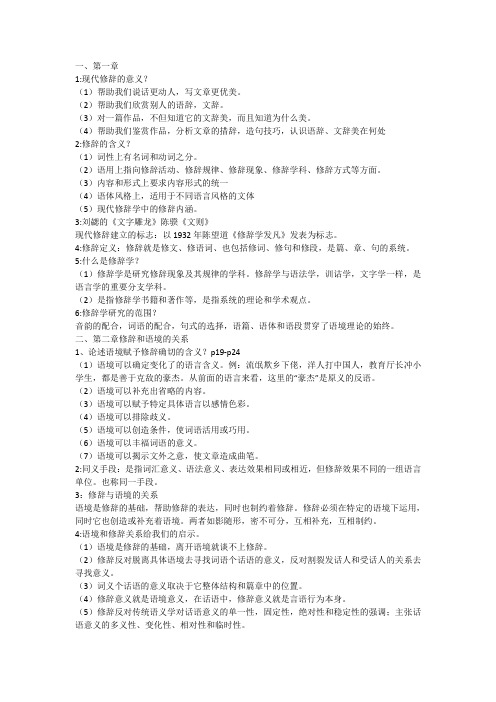
一、第一章1:现代修辞的意义?(1)帮助我们说话更动人,写文章更优美。
(2)帮助我们欣赏别人的语辞,文辞。
(3)对一篇作品,不但知道它的文辞美,而且知道为什么美。
(4)帮助我们鉴赏作品,分析文章的措辞,造句技巧,认识语辞、文辞美在何处2:修辞的含义?(1)词性上有名词和动词之分。
(2)语用上指向修辞活动、修辞规律、修辞现象、修辞学科、修辞方式等方面。
(3)内容和形式上要求内容形式的统一(4)语体风格上,适用于不同语言风格的文体(5)现代修辞学中的修辞内涵。
3:刘勰的《文字雕龙》陈骙《文则》现代修辞建立的标志:以1932年陈望道《修辞学发凡》发表为标志。
4:修辞定义:修辞就是修文、修语词、也包括修词、修句和修段,是篇、章、句的系统。
5:什么是修辞学?(1)修辞学是研究修辞现象及其规律的学科。
修辞学与语法学,训诂学,文字学一样,是语言学的重要分支学科。
(2)是指修辞学书籍和著作等,是指系统的理论和学术观点。
6:修辞学研究的范围?音韵的配合,词语的配合,句式的选择,语篇、语体和语段贯穿了语境理论的始终。
二、第二章修辞和语境的关系1、论述语境赋予修辞确切的含义?p19-p24(1)语境可以确定变化了的语言含义。
例:流氓欺乡下佬,洋人打中国人,教育厅长冲小学生,都是善于克敌的豪杰。
从前面的语言来看,这里的“豪杰”是原义的反语。
(2)语境可以补充出省略的内容。
(3)语境可以赋予特定具体语言以感情色彩。
(4)语境可以排除歧义。
(5)语境可以创造条件,使词语活用或巧用。
(6)语境可以丰福词语的意义。
(7)语境可以揭示文外之意,使文章造成曲笔。
2:同义手段:是指词汇意义、语法意义、表达效果相同或相近,但修辞效果不同的一组语言单位。
也称同一手段。
3:修辞与语境的关系语境是修辞的基础,帮助修辞的表达,同时也制约着修辞。
修辞必须在特定的语境下运用,同时它也创造或补充着语境。
两者如影随形,密不可分,互相补充,互相制约。
4:语境和修辞关系给我们的启示。
《汉语修辞学》复习资料
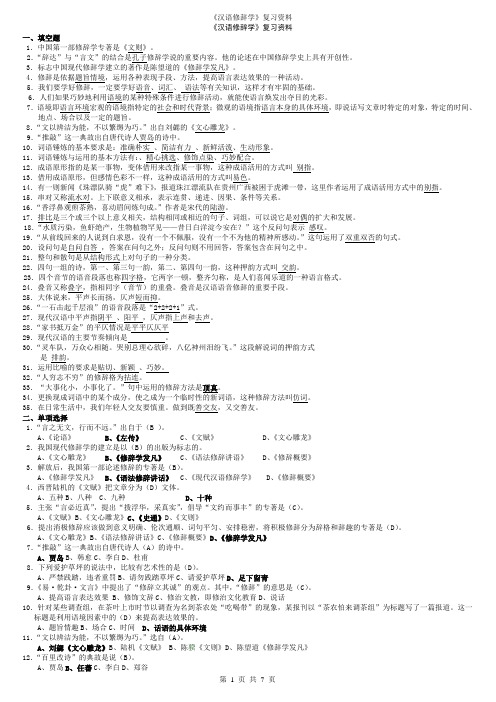
《汉语修辞学》复习资料一、填空题1.中国第一部修辞学专著是《文则》。
2.“辞达”与“言文”的结合是孔子修辞学说的重要内容。
他的论述在中国修辞学史上具有开创性。
3.标志中国现代修辞学建立的著作是陈望道的《修辞学发凡》。
4.修辞是依据题旨情境,运用各种表现手段、方法,提高语言表达效果的一种活动。
5.我们要学好修辞,一定要学好语音、词汇、语法等有关知识,这样才有牢固的基础。
6.人们如果巧妙地利用语境的某种特殊条件进行修辞活动,就能使语言焕发出夺目的光彩。
7.语境即语言环境宏观的语境指特定的社会和时代背景;微观的语境指语言本身的具体环境,即说话写文章时特定的对象,特定的时间、地点、场合以及一定的题旨。
8.“文以辨洁为能,不以繁缛为巧。
”出自刘勰的《文心雕龙》。
9.“推敲”这一典故出自唐代诗人贾岛的诗中。
10.词语锤炼的基本要求是:准确朴实、简洁有力、新鲜活泼、生动形象。
11.词语锤炼与运用的基本方法有:、精心挑选、修饰点染、巧妙配合。
12.成语原形指的是某一事物,变体借用来改指某一事物,这种成语活用的方式叫别指。
13.借用成语原形,但感情色彩不一样,这种成语活用的方式叫易色。
14.有一则新闻《珠漂队骑“虎”难下》,报道珠江漂流队在贵州广西被困于虎滩一带,这里作者运用了成语活用方式中的别指。
15.串对又称流水对。
上下联意义相承,表示连贯、递进、因果、条件等关系。
16.“香浮鼻观煎茶熟,喜动眉间炼句成。
”作者是宋代的陆游。
17.排比是三个或三个以上意义相关,结构相同或相近的句子、词组,可以说它是对偶的扩大和发展。
18.“水质污染,鱼虾绝产,生物植物罕见——昔日白洋淀今安在?”这个反问句表示感叹。
19.“从前线回来的人说到白求恩,没有一个不佩服,没有一个不为他的精神所感动。
”这句运用了双重双否的句式。
20.设问句是自问自答,答案在问句之外;反问句则不用回答,答案包含在问句之中。
21.整句和散句是从结构形式上对句子的一种分类。
中考语文修辞方法的复习
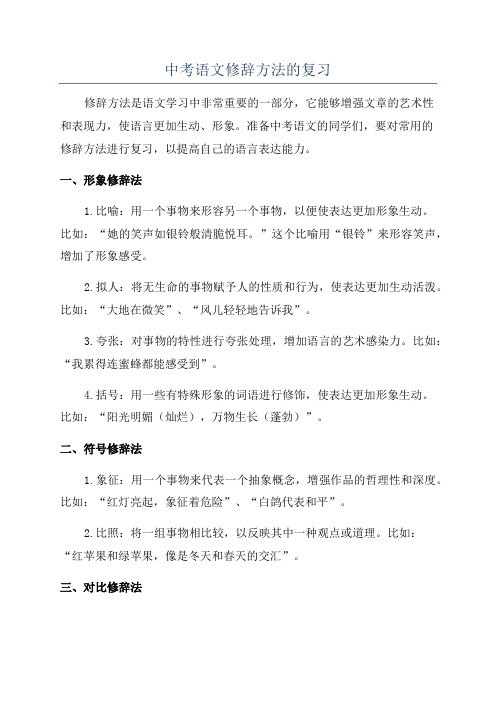
中考语文修辞方法的复习修辞方法是语文学习中非常重要的一部分,它能够增强文章的艺术性和表现力,使语言更加生动、形象。
准备中考语文的同学们,要对常用的修辞方法进行复习,以提高自己的语言表达能力。
一、形象修辞法1.比喻:用一个事物来形容另一个事物,以便使表达更加形象生动。
比如:“她的笑声如银铃般清脆悦耳。
”这个比喻用“银铃”来形容笑声,增加了形象感受。
2.拟人:将无生命的事物赋予人的性质和行为,使表达更加生动活泼。
比如:“大地在微笑”、“风儿轻轻地告诉我”。
3.夸张:对事物的特性进行夸张处理,增加语言的艺术感染力。
比如:“我累得连蜜蜂都能感受到”。
4.括号:用一些有特殊形象的词语进行修饰,使表达更加形象生动。
比如:“阳光明媚(灿烂),万物生长(蓬勃)”。
二、符号修辞法1.象征:用一个事物来代表一个抽象概念,增强作品的哲理性和深度。
比如:“红灯亮起,象征着危险”、“白鸽代表和平”。
2.比照:将一组事物相比较,以反映其中一种观点或道理。
比如:“红苹果和绿苹果,像是冬天和春天的交汇”。
三、对比修辞法1.对偶:通过对照对比的方式表达不同的事物或概念,使语言更加鲜明。
比如:“前途是光明的,道路是曲折的”。
2.反复:通过反复的对比,突出其中一种观点或感情色彩。
比如:“我疾奔在黑暗的夜路上,追赶着光明”。
3.省略:通过省略一些极具对比性的词语,使表达更加简洁明了。
比如:“他不怕困难,勇往直前;我则犹豫不决,止步不前”。
四、排比修辞法1.并列:通过列举多个具备相同特点的事物,加强表达的力度。
比如:“红红的花朵、绿绿的叶子、黄黄的果实”。
2.重复:通过重复一些词语、句子或句型,使表达更为突出。
比如:“我需要勇气,需要勇气去面对困难,需要勇气去实现梦想”。
3.省略:通过省略一些极具对比性的词语,使表达更加简洁明了。
比如:“我爱我的家乡,爱它的山川、爱它的湖泊、爱它的人民”。
五、夸张修辞法1.对景生情:通过描述美丽的自然景观,使人产生美好的情感。
现代汉语修辞学考试复习参考题

现代汉语修辞学考试复习参考题第一章修辞概说1.什么叫修辞、修辞活动以及修辞学?修辞学研究的对象指的是什么?修辞学:是研究在交际活动中如何提高语言表达效果的规律的科学,具有主观性。
修辞:是在交际活动中那些同语言的表达效果有关的现象,具有客观性;修辞学研究对象:凡是出于增强语言表达效果的动机,而有效地对语言材料进行选择、加工和调整的一切现象。
2.修辞学与语法学、语用学有什么联系?语法学与修辞学的联系:研究对象上:语法学研究语言的结构规律,修辞学研究如何提高语言的表达效果。
任务上:任何话语都是按照语法的规则生成的,语法是修辞的基础。
语法学分析语言的语法结构的特点;修辞学反映语言诸要素的综合运用。
语用学与修辞学的区别:语用学研究在不同的语言环境中如何运用和理解语言的问题;研究话语理解,即接受结果;研究制约语言使用的各种因素,注重规则阐释;修辞学一般只研究话语表达,主要从说(写)者的角度出发,研究表达效果;研究影响语言使用的条件,注重选择。
3.什么是修辞手法、修辞理论、语体风格?修辞学需要完成什么任务,且在完成任务时如何贯彻这三方面的内容?(1)修辞手法:包括如何选词,如何炼句,如何使用特殊的修辞方式(2)修辞理论:重在探讨修辞学的对象、范围、性质、任务、原则和修辞学与相关学科的关系(3)语体风格:一方面需要探讨各类语体的形成、特点、分类、功用,解决语体运用方面的不得体现象,并且研究语体发展的途径和方法,另一方面需要探讨风格同话语的表达效果之间的关系,研究风格是如何形成的,如何做到风格多样化,如何创造新的独特的风格。
(4)修辞学的任务,是在大量收集修辞现象的基础上,从修辞手法、修辞理论、语体风格三方面去探索规律。
4.举例说明修辞的原则是什么?答:①明确目标、看清对象②适用环境,注意场合③前后连贯,关照上下文④准确无误,清楚明白⑤生动形象,妥帖鲜明。
5.在锤炼词语、选择句式、及采用特殊的修辞手段等方面,如何增强表达的形象生动性,请举例说明。
修辞手法复习讲解大全
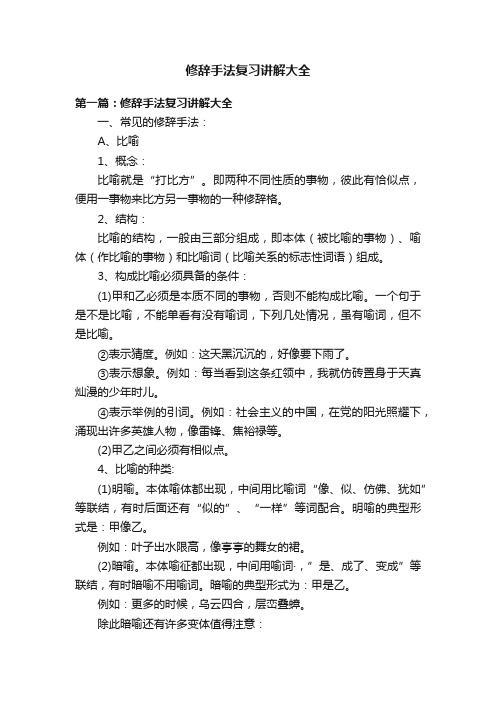
修辞手法复习讲解大全第一篇:修辞手法复习讲解大全一、常见的修辞手法:A、比喻1、概念:比喻就是“打比方”。
即两种不同性质的事物,彼此有恰似点,便用一事物来比方另一事物的一种修辞格。
2、结构:比喻的结构,一般由三部分组成,即本体(被比喻的事物)、喻体(作比喻的事物)和比喻词(比喻关系的标志性词语)组成。
3、构成比喻必须具备的条件:(1)甲和乙必须是本质不同的事物,否则不能构成比喻。
一个句于是不是比喻,不能单看有没有喻词,下列几处情况,虽有喻词,但不是比喻。
②表示猜度。
例如:这天黑沉沉的,好像要下雨了。
③表示想象。
例如:每当看到这条红领中,我就仿砖置身于天真灿漫的少年时儿。
④表示举例的引词。
例如:社会主义的中国,在党的阳光照耀下,涌现出许多英雄人物,像雷锋、焦裕禄等。
(2)甲乙之间必须有相似点。
4、比喻的种类:(1)明喻。
本体喻体都出现,中间用比喻词“像、似、仿佛、犹如”等联结,有时后面还有“似的”、“一样”等词配合。
明喻的典型形式是:甲像乙。
例如:叶子出水限高,像亭亭的舞女的裙。
(2)暗喻。
本体喻征都出现,中间用喻词·,”是、成了、变成”等联结,有时暗喻不用喻词。
暗喻的典型形式为:甲是乙。
例如:更多的时候,乌云四合,层峦叠蟑。
除此暗喻还有许多变体值得注意:①本体和喻体是修饰关系。
例如:从喷泉里喷出来洋,(“花”修饰“海洋”)②本体和喻体是注释关系。
例如:我爱北京——祖国的心脏。
(3)借喻。
不出现本体,直接叙述喻体。
借喻的典型形式为甲代乙。
例如:独有英雄驱虎豹,更元豪杰怕熊婴~傅喻。
连用几个比喻共说明一个本体。
例如:这种下笔以前的修改是最要紧不过的了,正如盖房子首先要打好图样,作战首先要订好计划一样。
5、比喻的作用:化平淡为生动;化深奥为浅显;化抽象为具体;化冗长为简洁。
B、比拟1、概念:比拟是把甲事物模拟作乙事物来写的修辞方式。
包括把物当作人来写(拟人);把人当作物来写(拟物)和把此物当作彼物来写(拟物)几种形式。
第一讲初中语文修辞专题复习

第一讲—初中语文的修辞运用一、知识考点归纳:8种常见的修辞:比喻、拟人、夸张、对偶、排比、反复、设问、反问,1.比喻比喻就是“打比方”,即两种不同性质的事物彼此有相似点,便用一事物来比方另一事物的一种修辞格。
它分为明喻、暗喻和借喻三种比喻有如下的作用:(1)用比喻来对事物的特征进行描绘或渲染,可以使事物生动形象、具体可感,给人以鲜明深刻的印象。
(2)用浅显常见的事物对深奥的道理加以表述,可以帮助人们深入理解。
也可以使语言简练、明快、形象。
2.拟人就是赋予事物以人格化的特征,把物当作人来写的一种修辞方法。
拟人具有思想的活跃性,能使读者展开想像的翅膀,捕捉它的意境,体味它的深意。
可以使读者不仅对所表达的事物产生鲜明的印象,而且感受到作者对该事物的强烈感情,从而引起共鸣。
3.夸张夸张是为达到某种表达的需要,对事物的形象、特征、作用、程度等方面善意扩大或缩小的一种修辞方法。
它包括扩大夸张和缩小夸张两种。
夸张作用:运用夸张能深刻地表现作者对事物鲜明的情感和态度从而引起读者的强烈共鸣;通过对事物形象的渲染,可以引起人们丰富的想像,有利于突出事物的本质和特征。
4.对偶对偶就是一对结构相同或相似、字数相等的句子对称地排列在一起,来表达相似、相关或相反、相对的意思的一种修辞方法。
对偶的作用:能鲜明地提示事物的内存联系,反映事物对立统一的辩证关系;形式整齐,结构匀称,看起来醒目,读起来顺口,听起来,便于记忆,便于传诵。
5.排比排比是由三个或三个以上结构相同或相似、内容相关、语气一致的短语或句子排列在一起,用来加强语势,强调内容,加重感情的一种修辞方法。
排比往往给人一气呵成之感,语言畅达,节奏感强,有气势,能增强文章的说服力和感染力。
排比多用于说理或抒情。
用排比说理,可以把论点阐述得更严密、更透彻;用排比抒情,可以把情感抒发得淋漓尽致。
6.反复反复是为了突出某种感情,强调某种意思,加深读者的印象,有意重复某些词语或句子的一种修辞方法。
修辞知识汇总

二十、回环:循环往复。 秀山青雨青山秀 香柏古风古柏香
雾锁山头山锁雾 天连水尾水连天
上海自来水来自海上
本日飞机飞日本
久慕秦郎假乱真时又逢春花含玉
十二、对比: 朱门酒肉臭,路有冻死骨。
十三、衬托:两者比较突出方。 正衬,如:冷风吹进船舱里,我的心禁不住悲凉起来了。 反衬,如:蝉噪林愈静,鸟鸣山更幽。
十四、引用:直接引用、间接引用。
十五、通感:感觉相通。她笑得很甜(视觉通味觉)。
十六、拈连:利用上下文联系,把用于甲的词语用于乙。 蜜蜂是在酿蜜又是在酿造生活。 吻孩子、吻医院、吻祖国。 十七、仿词:仿造新的词语。 白毛女、白毛男/公理、婆理/阔人,窄人/黑客,红客
五、对偶:
把字数相等,结构相似,意思相关的语句成对排列。如:
横眉冷对千夫指 俯首甘为孺子牛。 蒲叶桃叶葡萄叶,草本木本; 梅花桂花玫瑰花,春香秋香。 坐南朝北吃西瓜皮往东甩 思前想后读左传页朝右翻
山石岩下古木枯此木是柴 白水泉边女子好少女真妙 画上荷花和尚画 书临汉帖翰林书 福无双至 今朝至 祸不单行 昨夜行
一、比喻:本体——喻词——喻体
1.明喻:喻词“像” 等。如:我今天忙得像狗撵的一样。 2.暗喻:喻词“是” 等。如:书是进步的阶梯。 3.借喻:直接把甲说成乙,不用比喻词。
如:我们之间已经隔了一层可悲的厚障壁了。
注意比喻与真实含义的区别。 如:他长得像妈妈/他长得像猴子
二、借代:借用特征等相关的事物来代替原物。
如:一群红领巾跑过来。 白衣天使/五湖四海/诸葛亮/臭皮匠/大虾/菜鸟
三、比拟:把甲事物模拟作乙事物。
1.拟人:把物当人写。 2.拟物:把人当物写。 如:人们涌进了屋子。
四、夸张:着意扩大或缩小。
学考复习之九大修辞

学以致用:
下面没有用比拟手法的句子是: A.烟囱发出呜呜的声响,犹如在黑夜中哽咽。 B.被暴风雨压弯了的花草儿伸着懒腰,宛如刚从睡梦中苏醒。 C.远处林舍闪闪发亮,犹如姑娘送出的秋波,使人心潮激荡。 D.偎依在花瓣、绿叶上的水珠,金光闪闪,如同珍珠闪烁着光华。
A句中的烟囱“哽咽”、B句的花草儿“伸着懒腰”、D句中的水珠“偎依”都运用了拟人的手法。C句用的是比喻的手法,把闪闪发亮的“远处林舍”比作“姑娘送出的秋波”。
2
运用夸张要注意以下三点:
夸张不是浮夸,而是故意的合理的夸大,所以不能失去生活的基础和生活的根据。 脚下地球当球玩,大洋海水能喝干。 他跑起来速度像宇宙飞船,肯定能拿冠军。 稻田禾苗密又密,卫星掉下来也要把它弹到半空中。 夸张不能和事实距离过近,否则会分不清是在说事实还是在夸张。 苦干一个月,胜过两个月。 这句夸张因表述不明确,很难说是夸张还是事实 夸张要注意文体特征,如科技说明文、说理文章就很少用甚至不用夸张,以免歪曲事实。
五 排比
排比是由三个或三个以上结构相同或相似、内容相关、语气一致的短语或句子排列在一起,用来加强语势,强调内容,加重感情的修辞方式。
即一个句子中的一些成分组成排比。 例如:延安的歌声是黑夜的火把,雪天的煤炭,大旱的甘霖。
概念:
排比的种类:
(1)成分排比
例如:他们的品质是那样的伟大和高尚,他们的意志是那样的坚韧和刚强,他们的气质是那样的淳朴和谦逊,他们的胸怀是那样的美丽和宽广。
即一个复句的各个分句构成排比。
例如:八路军穿草鞋,把日本鬼子赶下海。解放军穿草鞋,把蒋家王朝踢下台。如今八连穿草鞋,把香风毒雾肢下踩。
(3)单句排比
(2)分句排比
(4)复句排比
例如:如果我们能够研制出一种类似鹰眼的搜索、观测技术系统,就能够扩大飞行员的视野,提高他们的视敏度。如果能研制出具有鹰眼视觉原理的“电子鹰眼”,就有可能用于控制远程激光制导武器的发射。如果能给导弹装上小巧的“鹰眼系统”,那么它就可以象雄鹰一样,自动寻找、识别、追踪目标,做到百发百中。
期末总复习(修辞)

期末总复习专题三修辞手法一、常见修辞手法:比喻、拟人、排比、夸张、反复、对偶、设问、反问等。
二、常见修辞的用法及作用:(一)比喻1、定义:比喻就是利用不同事物之间的某些相似的地方,借一个事物来比方另一个事物。
这个“不同事物”指两种不同类的事物,它们不仅形似,而且神似。
比喻一般由三个部分组成:被比喻的事物叫本体;作比喻的事物叫喻体;使本体和喻体发生相比关系的词叫比喻词。
例如:天上的云,有的像羽毛。
(句中的“云”是本体,“羽毛”是喻体,像是比喻词。
)2、分类:比喻又可以分为明喻、暗喻、借喻等三种基本类型。
(1)明喻,就是非常明显的比喻。
这种比喻,比喻词也都是些能够明显表示比喻的字眼。
例如:野花散在草丛里,像眼睛,像星星。
明喻一般用“像、好像、如、如同、似的、仿佛、像……一样、如同……一般”等比喻词连接。
例:春天想健壮的青年,有铁一般的胳膊和腰脚。
(2)暗喻,就是不明显的比喻。
连接本体和喻体的字眼儿不是鲜明的比喻词。
例如:天上,整个的是块空灵的蓝水晶。
(《济南的冬天》)那你就是比蝉更胜一筹的歌手了。
(《绿色蝈蝈》)暗喻是用“是”、“变成”、“成了”等比喻词把本体和喻体关联起来,这种比喻不明显,所以才称它是暗喻。
例: 落叶冲起一个偌大的蘑菇长在了空中。
(《风雨》)(3)借喻,这种比喻本体和比喻词全不出现,直接把喻体借过来代替本体。
例:看吧,山上的矮松越发的青黑,树尖上顶着一髻儿“白花”,好像日本看护妇。
★作用:运用比喻能够使深奥的道理变得浅显,让人更容易明白;使描写对象形象化,更加生动逼真;使语言简练、明快、生动;给人以丰富的想象。
例如:散在草丛里像眼睛,像星星,还眨呀眨的。
(生动形象地写出春天原野中草花的生长情况,描绘出闪闪发光,轻轻摆动的野花的色彩和形态。
)下列几种情况,不是比喻:同类相比。
例如:她的性格很像母亲;表示猜测。
例如:这天黑沉沉的,好像要下雨。
表示想象。
例如:每当看到这条红领巾,我仿佛置身于天真烂漫的少年时代。
修辞学期末考试复习资料
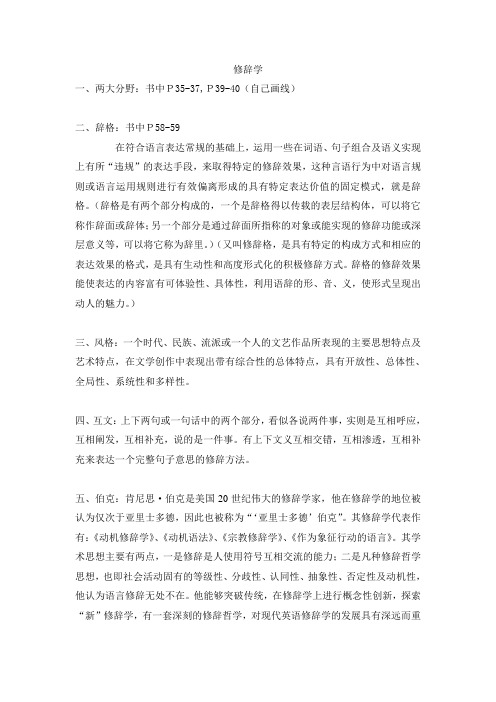
修辞学一、两大分野:书中P35-37,P39-40(自己画线)二、辞格:书中P58-59在符合语言表达常规的基础上,运用一些在词语、句子组合及语义实现上有所“违规”的表达手段,来取得特定的修辞效果,这种言语行为中对语言规则或语言运用规则进行有效偏离形成的具有特定表达价值的固定模式,就是辞格。
(辞格是有两个部分构成的,一个是辞格得以传载的表层结构体,可以将它称作辞面或辞体;另一个部分是通过辞面所指称的对象或能实现的修辞功能或深层意义等,可以将它称为辞里。
)(又叫修辞格,是具有特定的构成方式和相应的表达效果的格式,是具有生动性和高度形式化的积极修辞方式。
辞格的修辞效果能使表达的内容富有可体验性、具体性,利用语辞的形、音、义,使形式呈现出动人的魅力。
)三、风格:一个时代、民族、流派或一个人的文艺作品所表现的主要思想特点及艺术特点,在文学创作中表现出带有综合性的总体特点,具有开放性、总体性、全局性、系统性和多样性。
四、互文:上下两句或一句话中的两个部分,看似各说两件事,实则是互相呼应,互相阐发,互相补充,说的是一件事。
有上下文义互相交错,互相渗透,互相补充来表达一个完整句子意思的修辞方法。
五、伯克:肯尼思·伯克是美国20世纪伟大的修辞学家,他在修辞学的地位被认为仅次于亚里士多德,因此也被称为“‘亚里士多德’伯克”。
其修辞学代表作有:《动机修辞学》、《动机语法》、《宗教修辞学》、《作为象征行动的语言》。
其学术思想主要有两点,一是修辞是人使用符号互相交流的能力;二是凡种修辞哲学思想,也即社会活动固有的等级性、分歧性、认同性、抽象性、否定性及动机性,他认为语言修辞无处不在。
他能够突破传统,在修辞学上进行概念性创新,探索“新”修辞学,有一套深刻的修辞哲学,对现代英语修辞学的发展具有深远而重要的意义。
(伯克强调的是其应用的社会性。
他的修辞学理论的一个特点:1,重视语言的力量:语言即符号行为,修辞使人们活动由分到合;2,将演讲视为修辞活动的重要形式,不断丰富发展,西方修辞学由此建立了交际学的学术倾向,极大地扩充了修辞学的研究范围,打破了演讲模式的局限;3,修辞活动具有极强的方法论色彩,修辞活动重在研究如何把读者吸引过来的技巧,这个思路的深入探讨,出现了“叙述角度”、“审美距离”等跨越修辞学与文艺学的研究视野;4,修辞活动与伦理有关联;5,修辞能力可以锻炼。
汉语修辞学全套复习资料

3.修辞同语法有更直接的联系,充分研究同义句法形式以及各种不同句式综合运用的表达效果,应当是修辞的重要任务。比如,一般叙述和论说采用陈述句和判断句必较多,但也可以夹杂一些疑问句或者反诘句。比如,词序是汉语的一种重要形式,改变瓷壶往往就改变了意义,但是有的句子成分语法也允许他们在句子中有比较灵活的位置,强调语气产生某种特殊的情况。
3.同一种思维内容可以用多种不同的语言形式来表达,而同一种语言形式有时候也可以表达不同的思维内容。如今天天气真好和今天天气不赖。
4.有时候,同一个意思设置可以用互相对立的方法来表达。如,差一点摔跤和差一点没摔跤。
5.也有特殊的情况,在特定的语言环境中,由于修辞上的某种需要语言表达也可以在形式上突破思维规律的某些限制,但不能引起误会,不造成思维混乱。如“我的鞋子比你的鞋子大”可以缩写成“我的鞋子比你大”。
3.语言的社会环境和修辞的关系:
1.社会语言环境对语言的表达影响也很大,也是方方面面,不同时间地点身份心情目的等等都会影响说话人用不同的词语句式声调,口吻来说话。
四.修辞和逻辑
1.修辞和逻辑的关系:修辞学是研究提高语言表达效果的逻辑学则是研究人们思维形式和规律的,两者分属不同的学科。语言是思维的表现者,两者是内容和形式的关系。修辞应当以合乎逻辑为前提,如果表达的内容连事理都不合,文辞再美,也站不住,逻辑和语言表达的关系比较复杂。
1.不合乎语言习惯的话多数也是不合乎逻辑的,如“弟弟月饼吃”等。
三.修辞和语言要素
1.决定句子,文章正误优劣的四个方面的因素是什么?
1.事理,逻辑。就是说要看他的内容和不合情理,和不合思维规律。
修辞学复习题

修辞学复习题1.英语修辞学(Rhetoric)一名,其语源出于希腊语“雷屋”,盖水流之意——以谓人讲言语时,思想之表现,正如水之流泄。
2. 亚里士多德的《修辞学》给修辞学下的定义是:“修辞术是就每一事物觅出所有可能的说服方式的技能。
”“修辞术是说服的艺术。
”3. 伯克把修辞学定义为:“使用语言形成态度引发行动或导致他人采取某种行动”的科学。
4. 在汉语中“修辞”一词古已有之的。
《周易》中就曾引用孔子的话说:“子曰:君子进德修业。
忠信,所以进德也;修辞立其诚,所以居业也。
”“修辞”一词的出现,说明在当时人们已经形成有关修辞现象的概念了。
5. 陈望道:“修辞只不过是调整语辞使传情达意能够适切的一种努力。
”(《修辞学发凡》1932)6. 作为一门科学,修辞的主要特点是:(1)综合性。
修辞活动是一个人的全部社会文化知识的综合运用,也是一个人的世界观的体现。
(2)规则的相对性。
修辞的规则是有弹性的,相对的,模糊的。
逻辑管的是对不对,语法管的是通不通,修辞管的是好不好。
修辞的标准却不是绝对的,修辞的过程是一个选择的过程,受到多种因素的制约,因此,选择不是绝对的。
7. 修辞学在西方人的文化修养里,有过辉煌的昨天。
在漫长的中世纪里,修辞学与语法学、逻辑并立为“七艺”,而且居七艺之首。
在那时,修辞学是一门显学。
全称为“七种自由艺术”,是西欧中世纪早期学校中的七种主要学科。
即:文法学、修辞学、辩证法(逻辑学)、算术、几何学、天文学和音乐。
至公元4世纪时,七艺已被公认为学校的课程。
公元5、6世纪,七艺被基督教加以改造,为神学教育服务。
8. 古典修辞学的前身实际上是诞生在古希腊时期的古代雄辩术。
9. 古代的非洲和亚洲都没有产生演说术。
10.“智者”是公元前5—前4世纪希腊的一批收徒取酬的职业教师的统称。
他们以雅典为中心,周游希腊各地,对青年进行修辞、论辩和演说等知识技能的训练,教授参政治国、处理公共事务的本领。
11. 智者派在产生之初及前期的教育活动是受人称赞的,其中最著名的有普罗泰哥拉、高尔吉亚等人。
- 1、下载文档前请自行甄别文档内容的完整性,平台不提供额外的编辑、内容补充、找答案等附加服务。
- 2、"仅部分预览"的文档,不可在线预览部分如存在完整性等问题,可反馈申请退款(可完整预览的文档不适用该条件!)。
- 3、如文档侵犯您的权益,请联系客服反馈,我们会尽快为您处理(人工客服工作时间:9:00-18:30)。
修辞学复习(一)D efinition1. Choice of words(1). Denotation and connotationDenotation is the specific, direct, and literal meaning of a word.Connotation is the associative or suggestive meaning of a word.(2). General words and specific wordsappeal to the imagination, a vivid image, more informative and persuasive(3). Abstract words and concrete words(4). Long words and short words2. Choice of sentences(1) Simple sentences(2) Compound sentences(3) Complex sentences(4) Compound-complex sentences(5) Loose sentences(6) Periodic sentences(7) Long and short sentences3. Figures of speech(1) Phonetic figures of speech (choice of sounds)a.AlliterationIt is the repetition of initial consonant in a sequence of (一系列的) words.It is good for sound rhyme, musical effect and significant emphasis. It’s a great help to memory. By highlighting the sounds of words, alliteration catches the attention of the audience and makes the idea impressed deeply on the audience and thus easier for them to remember.b. Assonance ['æs(ə)nəns] 半韵,谐音It is the repetition or resemblance of vowel sounds in the stressed syllables of a sequence of words, preceded and followed by different consonants as in “late and make”. Assonance also refers to the likeness of sound in a series of words, as in “fair and square”. It’s a partial- or half-rhyme.It is often used in poetic language to create a musical rhythm for a particular effect of euphony.['juːf(ə)nɪ] 悦耳之音c. ConsonanceIt refers to the repetition of the final and identical consonants whose preceding vowels are different, words like sing—rang, dash—fish.Consonance, like alliteration and assonance, is often employed in poetry.d. Onomatopoeia[,ɒnə(ʊ)mætə'piːə] 拟声It is a term used to describe the phenomenon of language sounding like the thing if refers to.Onomatopoeia helps make description lifelike, add vividness or vitality to the description and give auditory description to break up a little the visual description that is often felt strenuous to understand. It helps make the implied exquisiteness of the diction more directly to the readers in an auditory way.(2) Semantic figures of speech 语义修辞格(what is semantic figure of speech?)a. Simile ['sɪmɪlɪ] 明喻Two concepts or two similar things are imaginatively and descriptively compared because they have at least one quality or characteristic in common or in resemblance. The commonest connectives are “like” and “as”.It’s to draw sharp pictures in the mind through comparisons, to give deeper insight into things, persons and ideas through suggestive association, or to explain abstract, complicated ideas in simple, concrete imagery.Four basic demands:⏹It has simile indicator such as “like”, “as”or “as if ”etc.⏹Two things involved in comparison: tenor and vehicle.⏹The two things mush be substantially different⏹The two things should be similar in at least one quality.Classification of Simile:⏹Descriptive Simile⏹Illuminative Simile⏹Illustrative Simile⏹Closed Simile⏹Open Simileb. MetaphorMetaphor uses words to indicate something different from their literal meaning--one thing is described in terms of another so as to suggest a likeness or analogy ([ə'nælədʒɪ] 类比,类似) between them.ClassificationThree requirements for metaphorCommon types of Metaphorc.MetonymyMetonymy involves the substitution of the name of one thing for that of another.For example, the name of a referent (指示物,指示对象) is substituted by the name of an attribute or entity related in some semantic way or by spatial proximity or by other reasons.Sources of Metonymy:⏹Body part⏹Name of a person⏹Name of a clear sign of an object or a person⏹Name of a place⏹Instrument⏹Trade mark or brand⏹Locationd. Synecdoche [sɪ'nekdəkɪ] 提喻法(以局部代表全部和以全部指部分)Synecdoche is a figure of speech by which a part is put for the whole,the whole for a part,the species for the genus,the genus for the species,or the name of the material for the thing made.Types of Synecdoche:⏹The part for the whole⏹The whole for the part⏹The abstract for the concrete, or the concrete for the abstract⏹The species for the genus,or the genus for the species⏹Name of the material for the thing made:e. PersonificationPersonification is a figure of speech which attributes human characteristics to impersonal things, such as animals, inanimate objects, or abstractions.It is usually employed to add vividness to expression.f. Synesthesia 通感As a rhetorical term, synesthesia refers to the mixing of sensations or the stimulation of one sense that produces a mental impression associated with a different sense.Synesthesia generally takes the following forms:◆Sense of vision mixed with sense of hearing◆Sense of vision mixed with sense of touch◆Sense of touch mixed with sense of hearing◆Sense of taste mixed with sense of hearing◆Sense of vision mixed with sense of taste◆Sense of vision mixed with sense of hearing◆Sense of smell mixed with other sense of modalitiesg.Transferred epithet 转移修饰Transferred epithet is a figure of speech in which an adjective properly modifying one noun is shifted to another noun in the same sentence.Transferred epithet bears the characteristics of brevity and vividness. According to the logical relationship between the word modifying and the word modified we can divide transferred epithets into three groups.◆Parallel relationship☐She sat there with embarrassed delight.☐He's recent kindness was winning a surprised gratitude from the lonely girl.◆Cause-effect/Effect-cause relationship☐He answered with a delighted smile,☐The warrant officer shook his head in numb astonishment☐The child gazed in wide-eyed amazement◆Modifying relationship☐He answered with a helpless smile.☐It is the law," remarked the ancient clerk, turning his surprised spectacles upon him.☐The sky turned to a tender Pallet of pink and blue.(3) Syntactic figures of speech 句法修辞格a. RepetitionRepetition is a powerful rhetorical device which creates good rhythm and parallelism to make the language musical, emphatic, attractive and memorable.Redundancy is a kind of faulty wording, which results from ideological confusion.Functions of Repetition:⏹Knit the ideas together⏹Emphasize an idea⏹Generate emotional forceClassification of Repetitionb. ParallelismParallelism is the repetition of syntactically similar constructions of coordinated sentences or phrases.Parallelism gives emphasis, clarity and coherence of ideas as well as the rhythm of the language.⏹Parallelism is often used in persuasive speech. It is either within a sentence oracross sentences, within a paragraph or across paragraphs.⏹Parallelism is deeply rooted in our mind. Some people even argue thatparallelism should be grouped into grammar because on so many occasions parallelism is a rule and a must.⏹Parallelism is often used together with repetition, either verbally orsyntactically. They make a very formidable pair in forceful writing of any kind.They help drive home a point.c. AntithesisAntithesis is placing contrasting ideas side by side for emphasis and rhythm.The elements (usually two) are contrary in meaning but similar in form.Arranged this way, the contrasting ideas provide a sharp and forceful way of measuring difference. Antithesis always gives strength, adds vividness and appeals to the audience's emotion. It results in linguistic brevity and rhythmic harmony.Ways of creating antithesis:⏹The use of antonyms⏹The reverse of the word orderd. ClimaxClimax is the arrangement of words, phrases, clauses or sentences in ascending order of importance.Ideas arranged in such a way develop gradually, like climbing a ladder, each idea outweighing the preceding one until reaching the summit.It is extremely effective in stirring up feelings and emotions, and helps to drive home a point.⏹Basic requirement:◆The progression of thought in climax must ascend at least three steps.◆Climax is often combined with repetitive devices such as parallelism,anaphora, epihora, etc.e. AnticlimaxIt is defined as “a sudden drop from the dignified or important in thought or expression to the commonplace or trivial, sometimes for humorous effect”; “a sudden often funny change from something noble, serious, exciting, etc., to something foolish, unimportant, or uninteresting esp. in a sp eech or piece of formal writing”.It is a figure of speech that involves stating one's thought in a descending order of significance or intensity, from the sublime to the ridiculous, from strong to weak, from weighty to light or frivolous.f. Syllepsis [sɪ'lepsɪs] 一语双叙法;兼用法;轭语法It is a construction in which the word that governs two or more other words means differently when it is collocated with these words separately.Syllepsis is often used for comic or satiric effect. To produce a witty, humorous or satirical effect, it ought to be original and creative.Structures of syllepsis:⏹one verb+two or more nouns or noun phrases☐He opened the door and her heart to the homeless child☐The senator picked up his hat and his courage.☐He lost his coat and his temper.⏹one adjective+two or more nouns☐He had short coat-tails and temper.☐Yesterday, he had a blue heart and coat.⏹two nouns+one verb☐At length down went her head and out came the truth and tears.☐Time and her aunt moved slowly.⏹one proposition+two or more nouns or noun phrases☐He fought with desperation and a stout club.☐She was serving soup with a ladle and a scowl.☐The businessmen left in high spirit and a Cadillac.g. Zeugma ['zjuːgmə] 轭式修饰法,拈连Zeugma is a figure of speech in which a word is used to modify or govern two or more words although its use is not grammatically or logically correct with all of them. Structures of Zeugma:⏹one verb+two or more nouns☐We ate a bun and a glass of milk.☐The sun shall not burn thee by day, nor the moon by night.☐At noons, Mrs. Turpin would get out of bed and humor, put on kimono, airs, and the water to boil for coffee. (O. Henry)⏹one adjective+ two or more nouns☐They went to the graveyard with weeping eyes and hearts.⏹one proposition + two or more nouns☐She was dressed in a maid's cap, a pinafore, and a bright smile.☐She left his apartment with tarnished virtue and a new mink.⏹two nouns + one noun☐I would my horse had the speed of your tongue.☐When I and my sorrows are dusth. ChiasmusIt is a construction involving the repletion of words or syntactic elements in reverse order (a b // b a).Chiasmus serves different purposes in different contexts. On many occasions it serves the purpose of being serious or solemn, witty or humorous. It often achieves aphoristic effect.Structures of Chiasmus:⏹Repetition of the words in reverse order⏹Repetition of the syntactic elements in reverse order.g. Rhetorical questionA rhetorical question is one that does not need an answer, for the answer is suggested by the speaker, or presumed by the speaker to be fairly obvious or probably known to the audience. In a sense, it is the equivalent of a statement.Functions of Rhetorical question:⏹Laying an emphasis, or getting the audience to be more involved andinterested.⏹Function as a transitional device⏹As an emotive device to suggest the speaker's outburst of emotion.Show a process of reasoning(4)Logical figures of speecha. HyperboleIt refers to a figure of speech where the speaker's description is stronger than is warranted by the state of affairs described, also known as exaggeration or over-statement.Both hyperbole and understatement have same purpose: to draw the attention of the audience to the subject or the idea so as to lay emphasis on it.Ways of creating hyperboles:⏹By the use of numerals⏹By the use of extreme words⏹By the use of certain adjectives and adverbs⏹By the use of superlative degree of adjectives or adverbs⏹By the use of nouns⏹By the use of verbsb. AllusionAllusion is usually a casual, brief and implicit reference to a famous historical or literary figure or a well-known historical event, which the writer assumes to be familiar to his readers.Sources of allusions:⏹Fairy tales, Myths, Legends and Fables⏹The Bible⏹English and American Literary Works⏹Modern and Contemporary Sources⏹Historical Figuresc. UnderstatementUnderstatement is a figure in which an idea is deliberately expressed too weakly. It is therefore the opposite of hyperbole.d. EuphemismEuphemism is a figure of speech in which something of an unpleasant, distressing, or indelicate nature is described in less offensive terms, it is the substitution of aninoffensive or pleasant expression for a more unpleasant one, or for a term which evokes more directly a distasteful or taboo subject.Its function is to give a better sounding name, to soften the shock of reality or, sometimes, to cover up dreadful facts.e. ParadoxA paradox is a figure of speech consisting of a statement or proposition which on the face of it seems self-contradictory, absurd or contrary to established fact or practice, but which on further thinking and study, may prove to be true, well-founded, and even to contain a succinct point.英语的某些警句、格言、谚语中常使用paradox这一辞格,使其说明的哲学道理更生动活泼,言简意赅,给人留下深刻印象。
